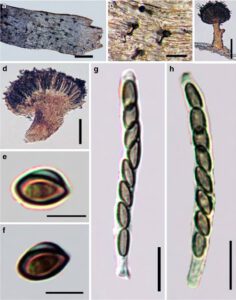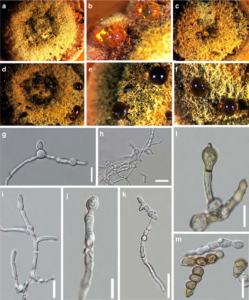Mycocalicium hyaloparvicellulum Daranag. & K.D. Hyde, in Ariyawansa et al., Fungal Diversity: 10.1007/s13225-015-0346-5, [102] (2015)
Index Fungorum number: IF551202; Facesoffungi number: FoF00707;
Etymology – Refers to the hyaline small celled ascospores; hyalo = hyaline; parvus = small; cellula = cell.
Holotype – MFLU 15-0667
Saprobic on cone of Pinus halepensis Miller. Sexual morph: Thallus crustaceous, solitary, erumpent, consist with a head and stipe. Apothecia 1000–1100 μm high (x̄ = 1083 μm, n=10), black, subglobose. Capitulum shiny, black, lenticular to subsphaerical, often irregular, with a granular surface. Hypothecium 80–95 μm wide (x̄ = 88 μm, n=10), dark brown to olivaceous brown. Excipulum 15–26 μm wide (x̄ = 21 μm, n=10), light brown, poorly–developed, arranged as a continuation of the outer layers of the stalk, comprising a few cell layers of textura irregulata, darker than the hyphae from the stalk. Stalk 1300–1500 μm high (x̄ = 1487 μm, n= 10), brown to pale brown, consisting of light brown periclinal parallel hyphae, with a gelatinous coat. Asci 56–83×4.3– 5.8 μm (x̄ = 72.5×4.8 μm, n=20), 8–spored, unitunicate, cylindrical, short pedicellate, apex strongly thickened, round, inconspicuously bluing in Meltzer’s reagent, apical apparatus,
globose. Ascospores 10–15×4–6 μm (x̄ = 12.9×5.3 μm, n= 20), uniseriate, ellipsoidal, one pointed end and rounded end, light brown, with a hyaline dwarf cell at one side (upper side), smooth-walled, with thin mucilaginous sheath. Asexual morph: Conidiophores 55–80×2.6–3.4 μm (x̄ = 77× 3.1 μm, n=20), some are longer, emerging through the thick mycelium, which formed into hyphal aggregates, immature conidiophores hyaline, becoming light brown at maturity, complex, dichotomously branched, septate. Conidiogenous cells 10–14×3.2–4.5 μm (x̄ = 12.9×4.3 μm, n=20), terminal, single, cylindrical and elongated, with smoothly curved apex. Conidia 5.2–7.5 μm diam. (x̄ = 6.3 μm, n=20), light brown, globose, always occurs as conidial chains of 4–5 conidia, rarely observed single conidia.
Culture characteristics – Colonies on Difco OA plates reaching 5 cm edge Petri dish in 1 month at 25–28 °C, at first citrine or grey olivaceous, felty, zonate, with diffuse margins, after three weeks become olivaceous and isebelline and zonate; reverse turning brown and then to dark brown almost black, zonate.
Material examined – Italy, Cosenza Province, Rocca Imperiale, on a cone of Pinus halepensis (Pinaceae), 5 April 2013, Lugaresi Renzo (MFLU 15-0667, holotype), living culture, MFLUCC 14-0169.
Notes – Mycocalicium hyaloparvicellulum has a close relationship with Mycocalicium subtile (Pers.) Szatala, but differs in apothecium size, colour and structure of stalk, ascus size and spore dimensions and colour (Muniz and Hladun 2007). Like Mycocalicium llimonae, M. hyaloparvicellulum was also isolated from a cone of Pinus halepensis. Mycocalicium llimonae is a saprobe on pine cones on dry branches of Pinus halepensis and several other Pinus spp. (Muniz and Hladun 2007) . Mycocalicium llimonae differsfrom M. hyaloparvicellulum in having smaller apothecia with hyaline stalks. In the phylogenetic analysis (Fig. 2), M. hyaloparvicellulum is a distinct species with high bootstrap support within the Mycocalicium clade.


